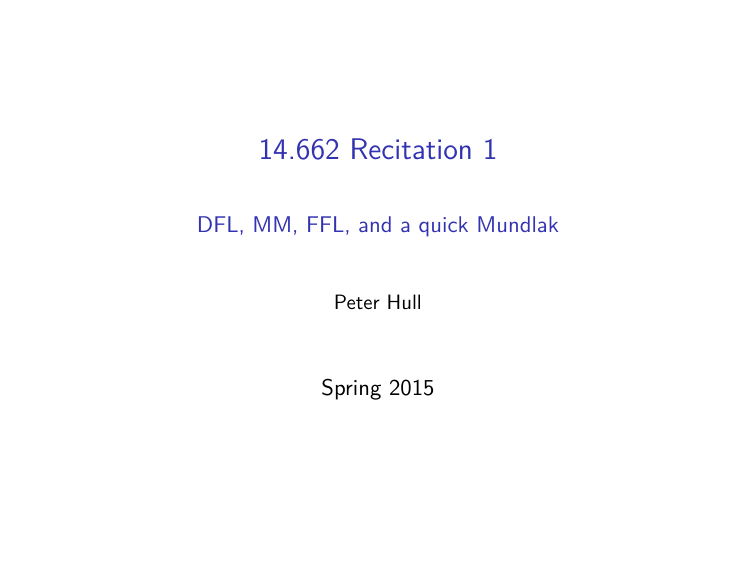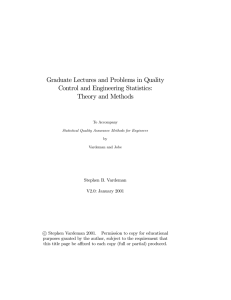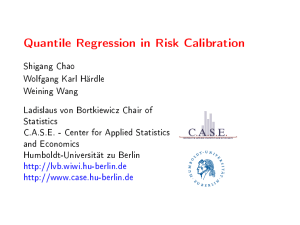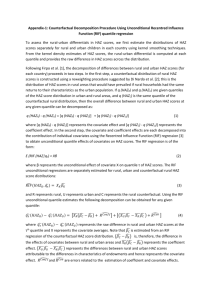Recitation 1 14.662 MM, FFL, and a quick Mundlak DFL,
advertisement

14.662 Recitation 1
DFL, MM, FFL, and a quick Mundlak
Peter Hull
Spring 2015
Part 1: DiNardo, Fortin, and Lemieux (1996)
Part 1: Review: DiNardo, Fortin, and Lemieux (1996)
1/19
Part 1: DiNardo, Fortin, and Lemieux (1996)
Motivation
Why All the Fancy New ’Metrics?
Growing interest in the distribution of wages
Would like to link distributional features of Yi to other factors, Xi
As a descriptive task (e.g. “how much of the 90th -10th percentile gap
in wages can we explain by differences in education?”)
To answer causal questions (e.g. “what would happen to the 10th
percentile of earnings if we made community college free?”)
OLS/IV are all about means; to say something about other
distributional features, we have to learn some new skills
In some cases (e.g. “conditional” v. “unconditional” quantile
regression), we have to face issues that OLS inherently sidesteps
2/19
Part 1: DiNardo, Fortin, and Lemieux (1996)
DiNardo, Fortin, and Lemieux (1996)
DFL ’96 Overview
DFL extend the Oaxaca-Blinder mean-decomposition intuition to
decompose wage distributions
Basic idea: write
f (w ; tw , tz ) =
z
f (w |z, tw , tz )dF (z|tw , tz )
where w = wage, z = individual attributes, tv = “time”
(parameterizes distribution of v )
Assume f (w |z, tw , tz ) = f (w |z, tw ), dF (z|tw , tz ) = dF (z|tz ):
f (w ; tw = t, tz = t ' ) =
z
f (w |z, tw = t)dF (z|tz = t ' )
z
f (w |z, tw = t)ψ(z; t ' , t)dF (z|tz = t)
=
where
ψ(z; t ' , t)
≡ dF (z|tz = t ' )/dF (z|tz = t)
3/19
Part 1: DiNardo, Fortin, and Lemieux (1996)
DiNardo, Fortin, and Lemieux (1996)
DFL ’96 Results
ψ(z; t ' , t) a “reweighting” that gives a “counterfactual” distribution
of wages when t ' = t (like O-B)
Once you estimate ψ(z; t ' , t), you can estimate (by KDE) “the density
[of wages] that would have prevailed if individual attributes had
remained at their 1979 level and workers had been paid according to
the wage schedule observed in 1988”
By Bayes’ rule:
ψ(z; t ' , t) ≡
P(z|t ' ) P(t ' |z) · P(z)/P(t ' ) P(t ' |z) P(t)
=
=
P(z|t)
P(t|z) · P(z)/P(t)
P(t|z) P(t ' )
and it’s easy to estimate these pieces (DFL use probit)
DFL show this decomposition, while also accounting for changes in
unionization rates and the min. wage (see notes for details). Find a
lot of residual difference between 1979 and 1988 wage distribution
Reminder #1: decomposition order matters (as with O-B)
Reminder #2: partial equilibrium exercise (by assumption)
4/19
Part 2: Quantile Methods
Part 2: Quantile Methods
5/19
Part 2: Quantile Methods
Conditional Quantile Regression
Conditional QR: a Review
The quantile function QY is defined as the inverse of a CDF:
QY (τ|Xi ) = y ⇐⇒ FY (y |Xi ) = τ
It is thus invariant to monotone transformations T (·):
QY (τ|Xi ) = y =⇒ P(Yi ≤ y |Xi ) = τ =⇒
P(T (Yi ) ≤ T (y )|Xi ) = τ =⇒ QT (Y ) (τ|Xi ) = T (QY (τ|Xi )) = T (y )
Conditional QR models QY (τ|Xi ) as a linear function of Xi :
QY (τ|Xi ) =Xi' βτ
This implies (can verify by writing out integrals and taking FOC):
βτ = arg min E ρτ (Y − Xi' b)
b
ρτ (ε) ≡
τε,
ε ≥0
(1 − τ)|ε|, ε < 0
6/19
Part 2: Quantile Methods
Conditional Quantile Regression
Interpreting Conditional QR
A linear QY (τ|Xi ) is consistent with a location-scale model:
Yi = Xi' α + Xi' δ εi , εi ⊥
⊥ Xi
Since Yi is monotone in εi conditional on Xi :
QY (τ|Xi ) = Xi' α + Xi' δ Qε (τ|Xi )
= Xi' α + Xi' δ Qε (τ) = Xi' βτ
βτ is the effect of Xi on the τ th quantile of Y (not the effect on the
τ th quantile individual)
If Xi is multidimensional, βτ,1 is the effect of Xi,1 on the τ th quantile
of Y , conditional on Xi,2 . . . Xi,k
Ex: Xi = Di
Wi'
'
for Di binary: βτ,1 = quantile treatment effect
7/19
Part 2: Quantile Methods
Conditional Quantile Regression
Why is QR “Conditional” when OLS is not?
Suppose Yi = β Di + Wi' γ + (1 + Di ) εi with εi ⊥
⊥ D i , Wi
=⇒ Both E [Y |Di , Wi ] and QY (τ|Di , Wi ) are linear
Both QR and OLS give the conditional effect of Di on Yi :
E [Y1i |Wi ] − E [Y0i |Wi ] = β + Wi' γ + E [2εi ] − Wi' y + E [εi ]
=β
QY1 (τ|Wi ) − QY0 (τ|Wi ) = β + Wi' γ + 2Qε (τ) − Wi' γ + Qε (τ)
= β + Qε (τ)
But not necessarily the unconditional effect:
E [Y1i ] − E [Y0i ] =β + E [Wi' γ] + E [2εi ] − E [Wi' γ] + E [εi ]
=β
QY1 (τ) − QY0 (τ) =β + QW ' γ+2ε (τ) − QW ' γ+ε (τ)
6=
=β + QW ' γ (τ) + 2Qε (τ) − QW ' γ (τ) + Qε (τ)
8/19
Part 2: Quantile Methods
Machado and Mata (2005)
“Unconditioning” QR: Machado and Mata (2005)
Skorohod representation: Yi = QY (θi |Xi ) for θi |Xi ∼ U(0, 1), because
θi = FY (Yi |Xi ) =⇒ θi |Xi ∼ U(0, 1)
QY (θi |Xi ) = QY (FY (Yi |Xi )|Xi ) = Yi
M&M Marginalizing Method:
1
Y
∀w ∈ supp(Wi ), draw θi , simulate YY
1wi , Y0wi
2
Y
Average up YY
1wi , Y0wi
QY (θi |Di , Wi )
with Q
by fQ
W (w )
Y
Y
Compute Q
Y1 (τ) − QY0 (τ)
Simple, right?
...not really.
Computationally demanding (especially if you bootstrap SEs!)
Can be quite sensitive to linear approximation of QY (θi |Di , Wi )
Curse of dimensionality: f
fW (w ) can be poorly estimated
3
9/19
Part 2: Quantile Methods
Firpo, Fortin, and Lemieux (2009)
“RIF-ing” QR: Firpo, Fortin, and Lemieux (2009)
Graphical intuition:
Unconditional effect on the τ th quantile:
FY (QY0 (τ)) − FY1 (QY0 (τ))
QY1 (τ) − QY0 (τ) ≈ 0
fY0 (QY0 (τ))
10/19
Part 2: Quantile Methods
Firpo, Fortin, and Lemieux (2009)
Influence Functions: A Quick Overview
Q: “What happens to statistic TX (F ) if I peturb F by adding mass at x ”?
A:
TX ((1 − ε)F + εδx ) − TX (F )
IF (x ; TX , F ) = lim
ε→0
ε
Ex. 1: TX (F ) = EX ∼F [Xi ]:
EX ∼(1−ε)F +εδx [Xi ] − EX ∼F [Xi ]
ε→0
ε
(1 − ε)EX ∼F [Xi ] + εEX ∼δx [Xi ] − EX ∼F [Xi ]
= lim
ε→0
ε
−εEX ∼F [Xi ] + εEX ∼δx [Xi ]
= lim
= x − µX
ε→0
ε
IF (x ; TX , F ) = lim
Ex. 2: TY (F ) = QY ;F (τ):
IF (y ; TY , F ) =
τ − 1{y ≤ QY ;F (τ)}
fY (QY ;F (τ))
11/19
Part 2: Quantile Methods
Firpo, Fortin, and Lemieux (2009)
Recentered Influence Functions
FFL define:
RIF (y ; QY ;F (τ), FY ) = QY ;F (τ) +
τ − 1{y ≤ QY ;F (τ)}
fY (QY ;F (τ))
Note the expectation of RIF (x ; TX , F ) is just TX (F ):
τ − E [1{Yi ≤ QY ;F (τ)}]
fY (QY ;F (τ))
τ −τ
= QY ;F (τ)
= QY ;F (τ) +
fY (QY ;F (τ))
E [RIF (Yi ; QY ;F (τ), FY )] = QY ;F (τ) +
So if E [RIF (Yi ; QY ;F (τ), FY )|Xi ] = Xi' β ,
QY ;F (τ) = E [RIF (Yi ; QY ;F (τ), FY )]
= E [E [RIF (Yi ; QY ;F (τ), FY )|Xi ]]
= E [Xi' ]β
Coefficients of a conditional RIF also describe unconditional quantiles
12/19
Part 2: Quantile Methods
Firpo, Fortin, and Lemieux (2009)
Identifying RIFs
τ − E [1{Yi ≤ QY ;F (τ)}|Xi ]
fY (QY ;F (τ))
τ − (1 − P (Yi > QY ;F (τ)|Xi ))
= QY ;F (τ) +
fY (QY ;F (τ))
P (Yi > QY ;F (τ)|Xi )
= cτ +
fY (QY ;F (τ))
E [RIF (Yi ; QY ;F (τ), FY )|Xi ] = QY ;F (τ) +
If E [RIF (Yi ; QY ;F (τ), FY )|Xi ] = Xi' β ,
cτ +
P (Yi > QY ;F (τ)|Xi )
= Xi' β
fY (QY ;F (τ))
=⇒ E [Ti |Xi ] = −aτ + fY (QY ;F (τ))Xi' β
where Ti = 1{Yi > QY ;F (τ)}
13/19
Part 2: Quantile Methods
Firpo, Fortin, and Lemieux (2009)
Estimating RIFs
E [Ti |Xi ] = −cτ + fY (QY ;F (τ))Xi' β
So
Ti = −cτ + fY (QY ;F (τ))Xi' β + εi
where E [εi |Xi ] = 0
A regression!
Estimate (best linear approximation to the) RIF by:
1
2
3
Regressing Ti = 1{Yi > QY ;F (τ)} on Xi
Dividing βˆ by ffY (QY ;F (τ))
That’s it!
14/19
Part 2: Quantile Methods
Firpo, Fortin, and Lemieux (2009)
RIF Limitations
RIF approximation depends crucially on the estimated ffY (QY ;F (τ))
RIF inherently marginal: influence f’n describes small changes in Xi
MM ’05: “What is the avg. difference in quantiles of Y1i and Y0i ?”
(see also Chernozhukov et al. 2009)
FFL ’09: “What is the avg. effect on the quantile of Yi if we were to
randomly switch one individual from Di = 0 to Di = 1?”
As with all decomposition methods, RIFs reflect a “partial
equilibrium”: changes in Di holding Wi fixed
...but at least it can describe the unconditional distribution!
15/19
Bonus: Mundlak as OVB
Bonus: Mundlak as OVB
16/19
Bonus: Mundlak as OVB
The Mundlak Decomposition
As David showed in class, the fixed-effects regression
Yij = α + r l Sij + µj + εij
implies a decomposition of the coefficient from regressing Yij on Sij :
rs = rl +λb
where
λ=
Cov (µj , S¯j )
Var (S̄j )
b=
Cov (S̄j , Sij )
Var (Si )
We can think of λ as the return to mean establishment schooling and b as
the association between worker and establishment schooling
17/19
Bonus: Mundlak as OVB
Mundlak as OVB
We can derive this decomposition from the classical omitted variables bias
formula:
r s = 'r'"
rl +
1
'r'"
'r'"
"short" "long" "effect of omitted"
Cov (µj , Sij )
Var (Sij )
'
r'
"
"regresion of omitted on included"
Define
S̃ij = Sij − S̄j
which is the “within establishment” variation in Sij (i.e. the residual from
regressing Sij on establishment FEs. By construction
Cov (S̄j , Sij ) = Cov (S̄j , S¯j + S̃ij )
= Var (S̄j )
18/19
Bonus: Mundlak as OVB
Mundlak as OVB (cont.)
Therefore,
rs = rl +
= rl +
Cov (µj , S¯j + S̃ij ) Var (S̄j )
Cov (µj , S¯j + S̃ij )
= rl +
Var (S̄j )
Var (S̄j + S̃ij )
Var (S̄j + S̃ij )
Cov (µj , S¯j ) Cov (S̄j , Sij )
Var (S̄j )
Var (S̄j )
since Cov (µj , S˜ij ) = 0, also by construction. This is Mundlak.
We can also use OVB intuition to estimate this decomposition; note that
rs = rl +λ
Cov (S̄j , Sij )
Var (Si )
is the OVB formula for the “long” regression of
Yij = α l + r l Sij + λ S̄j + εijl
which we can run to estimate λ (and then solve for b)!
19/19
MIT OpenCourseWare
http://ocw.mit.edu
14.662 Labor Economics II
Spring 2015
For information about citing these materials or our Terms of Use, visit: http://ocw.mit.edu/terms.


